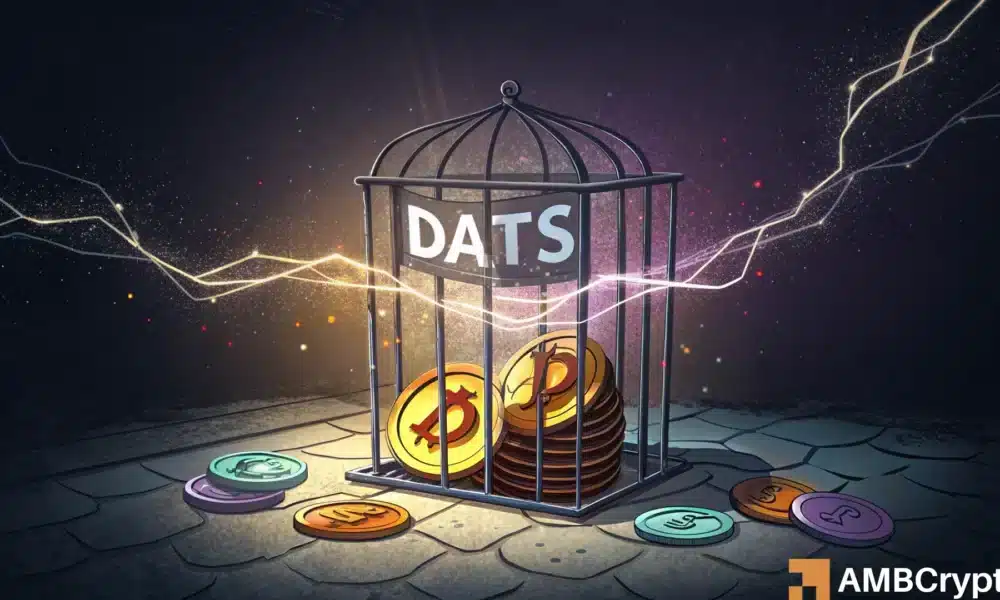The Decline of DeFi Weekly Inflows: Analyzing the Current State of Crypto and Digital Asset Treasuries
In recent months, the decentralized finance (DeFi) landscape has experienced a substantial shift, evidenced by the data from DeFiLlama indicating that weekly inflows plummeted from an astounding $5.57 billion in July 2025 to a mere $259 million by November. This represents a staggering 95% drop, raising concerns about the overall health of the DeFi ecosystem and broader cryptocurrency market. With a considerable shift in market sentiment and decreasing confidence among institutional buyers, understanding the reasons behind this decline is crucial for investors and enthusiasts alike.
A Weakening Market Sentiment
The decline in inflows can be attributed mainly to the weakening sentiment across the broader market. Recent struggles to recover from a tariff-driven crash have left investors jittery. Many corporate buyers, who once viewed cryptocurrencies as both a hedge against inflation and a growth asset, are now stepping back. This marks a significant change from previous bullish trends that attracted institutional interest. There is a growing belief that the previously hyped institutional treasury strategy may have reached a pause or reset phase, pushing many to reconsider their investment strategies.
Diverging Performance: Bitcoin vs. Digital Asset Treasuries
Over the past three months, a notable performance gap has emerged between Bitcoin (BTC) and Digital Asset Treasuries (DATs). While Bitcoin has only declined by around 10%, many DAT-linked assets have suffered catastrophic losses, plummeting between 40% and 90%. This sharp divergence is particularly alarming, as it highlights the vulnerability of several DATs, including those associated with projects like Metaplanet and Naka. Despite BTC’s relatively stable market value, the decline in DATs is forcing managers to evaluate their strategies amid growing concerns about future performance.
Pressure on Digital Asset Treasures Managers
As losses accumulate and asset premiums vanish, DAT managers find themselves under increasing pressure to make difficult decisions. They must weigh the pros and cons of pausing new purchases versus continuing operations in a challenging environment. Analysts have observed that most major DATs are now trading below their average crypto purchase prices, amplifying the urgency for managers to act. The fear of issuing new stock at a discount could inhibit value creation, as funds remain trapped with assets acquired at peak prices.
Potential Market Impact of Liquidation
The potential for forced liquidation of holdings poses risks not only for the DATs but also for the larger cryptocurrency market. If DAT managers are compelled to liquidate their substantial holdings in Bitcoin, Ethereum (ETH), and Solana (SOL), it could significantly amplify selling pressure across the market. This scenario risks testing the resilience of the entire DAT model, potentially leading to further declines in crypto prices and investor confidence. The interconnected nature of the markets means that a downturn in one area can ripple through others, affecting even the most stable digital assets.
Moving Forward: Strategies for Recovery
To navigate the current climate, investors and managers in the DeFi space need to adopt more cautious and strategic approaches. It may involve diversifying portfolios, reevaluating risk management strategies, and seeking alternative investment avenues that align better with current market conditions. Understanding consumer sentiment and maintaining transparency may also be vital in restoring investor confidence. In this changing landscape, the ability to adapt to market dynamics will be crucial for sustaining growth and fostering long-term investments.
Conclusion: The Evolving DeFi Landscape
The recent decrease in weekly inflows within the DeFi sector underscores the need for a new perspective on cryptocurrency investments. The diverging performance between Bitcoin and Digital Asset Treasuries serves as a cautionary tale about market volatility and the importance of risk management. As market sentiment continues to evolve, solutions must be sought that not only stabilize the current situation but also pave the way for future growth. By remaining agile and informed, investors can navigate the complexities of the DeFi market and position themselves for potential recovery in an unpredictable environment.


